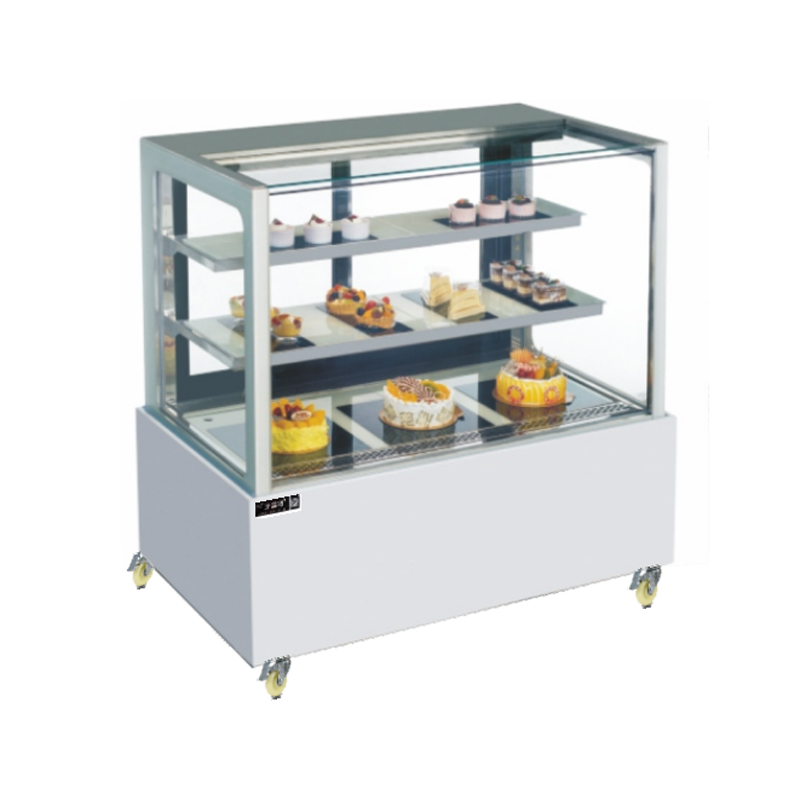2025-04-24
How Do Open vs. Closed Refrigerated Display Cases Compare in Terms of Efficiency and Usability?
1. Energy Efficiency: Open vs. Closed Display Cases
One of the most significant differences between open and closed refrigerated display cases lies in their energy efficiency.
Closed refrigerated display cases are typically more energy-efficient than open cases. This is because the glass doors or panels in closed cases prevent the cold air from escaping into the surrounding environment, maintaining a consistent internal temperature. The sealed design of closed units helps to reduce the workload of the refrigeration system, meaning the compressor doesn't have to work as hard to cool the display. As a result, closed display cases tend to have lower energy costs, which can be a significant consideration for businesses aiming to reduce operational expenses.
2. Product Visibility and Accessibility
Open refrigerated display cases shine in terms of product visibility and customer accessibility. With no doors to hinder access, these cases make it easy for customers to browse and pick products freely, encouraging more interaction. Open cases are often placed in high-traffic areas of stores to attract attention and promote impulse purchases. The open design also gives customers an unobstructed view of the products inside, which can be especially beneficial for showcasing fresh items like bakery goods, salads, and beverages that rely on visual appeal to sell.
Closed refrigerated display cases, while offering slightly reduced visibility due to the glass doors, can still maintain a high level of product presentation, especially if the case is well-lit. While customers must open the doors to access the products, this design still allows for clear visibility through the transparent glass, making it easier for customers to browse from outside the case. Additionally, closed cases can offer better protection for products, keeping them cleaner and reducing the risk of contamination from outside elements like dust, dirt, and germs.
3. Temperature Control and Food Safety
The ability to maintain consistent temperature control is another area where closed refrigerated display cases have a distinct advantage. Closed cases provide better temperature stability because the cold air remains contained within the unit, reducing the risk of temperature fluctuations. This is especially crucial for storing temperature-sensitive products, such as meats, dairy, or seafood, where even minor temperature variations can lead to spoilage or loss of product quality.

Open refrigerated display cases, while convenient and user-friendly, face challenges in maintaining temperature control. Since the air is not contained, the refrigeration system needs to work harder to compensate for the loss of cold air, which can result in temperature inconsistencies. In high-traffic areas, customers constantly opening the display can also cause fluctuations in the temperature, leading to potential food safety concerns. While some newer open cases come with air curtains to minimize temperature variations, they still may not provide the same level of temperature control as closed systems.
For businesses handling perishable items that require strict temperature regulations, closed refrigerated display cases are often the safer option in terms of maintaining consistent food safety standards.
4. Customer Experience and Interaction
Open refrigerated display cases create a more engaging customer experience by allowing for easy and direct interaction with the products. Since customers don’t have to open a door to access the products, they can quickly grab what they need, making the shopping experience faster and more convenient. The open design also promotes impulse buying, as customers can quickly spot items they may not have been planning to purchase.
In contrast, closed refrigerated display cases can make the customer experience slightly less interactive. Customers must open a door to access products, which could discourage impulse purchases and make the shopping experience feel more transactional. However, closed cases can still provide a satisfying customer experience if the case is designed with convenience in mind, such as featuring easy-to-use sliding doors or push-to-open mechanisms.
5. Aesthetic Appeal and Store Design
Both open and closed refrigerated display cases can contribute significantly to a store's overall aesthetic, but they serve different purposes in terms of visual appeal. Open display cases tend to create a more inviting and dynamic look. The absence of doors encourages a sense of openness and accessibility, and the exposed design is often used in stores that want to highlight fresh, artisanal, or ready-to-eat items. Open cases also work well in smaller spaces, as they don’t create the barrier of doors that closed cases do.
On the other hand, closed refrigerated display cases provide a more streamlined, neat, and organized appearance. The glass doors give the display a more polished look and allow products to be clearly visible without any distractions. Closed cases are often used in environments where products need to be kept clean and protected, such as in supermarkets, butcher shops, and pharmacies. Closed cases also offer a more cohesive appearance in larger stores where the visual flow of the space is essential.
6. Cost Considerations
Cost is a major factor when deciding between open and closed refrigerated display cases. Open refrigerated display cases are often more affordable upfront compared to closed models. However, due to their higher energy consumption, they may lead to higher long-term operational costs. Additionally, open cases may require more frequent maintenance or cleaning due to the lack of protection from external contaminants.
Closed refrigerated display cases, while typically more expensive initially, offer better energy efficiency and lower operating costs in the long run. The added protection against temperature fluctuations and contamination may also reduce the risk of product loss, leading to cost savings over time. Closed cases are often seen as a more cost-effective choice in environments where energy consumption and food safety are top priorities.

 English
English русский
русский Español
Español عربى
عربى






